The global axillary hyperhidrosis treatment market is valued at USD 1.9 billion in 2025 and is expected to reach USD 3.4 billion by 2035, which shows a CAGR of 6%. Demand is being propelled by rising awareness around the psychological and social impact of excessive underarm sweating. North America currently represents the largest regional market due to early product access and insurance coverage, while South Asia & Pacific, especially India, is expected to register faster growth rates over the forecast period.
Growing discomfort related to personal aesthetics, body odor, and public embarrassment has significantly elevated the need for reliable hyperhidrosis treatments. Antiperspirants and medicated wipes remain widely used, but patients increasingly seek alternatives with longer-lasting effects. Drug therapy, particularly botulinum toxin injections and new topical formulations, has seen greater adoption owing to its convenience and relatively lower cost compared to procedural options.
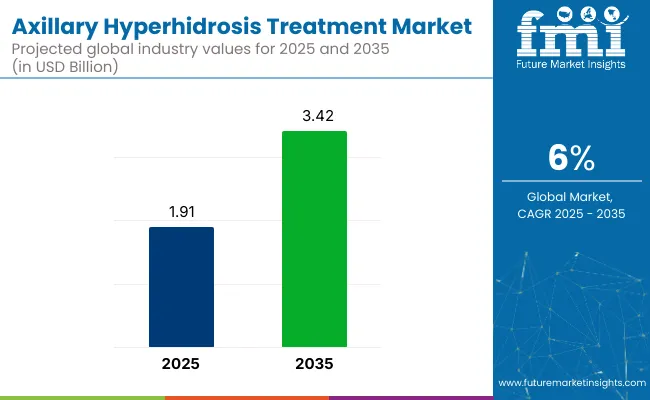
| Metric | Value |
|---|---|
| Estimated Market Size (2025) | USD 1.9 billion |
| Projected Market Size (2035) | USD 3.4 billion |
| CAGR (2025 to 2035) | 6% |
Innovations in non-invasive treatment modalities are playing a central role in reshaping the clinical landscape. FDA-approved products like Sofpironium bromide gel and the Brella SweatControl Patch have created new therapeutic pathways for individuals resistant to traditional antiperspirants. Minimally invasive technologies such as microwave thermolysis are also contributing to broader acceptance of clinical procedures, supported by efforts to improve reimbursement schemes and patient education.
However, certain barriers to adoption persist. Many treatments provide only short-term relief, necessitating repeated visits or long-term pharmaceutical adherence. Additionally, side effects from anticholinergic drugs or cost-related concerns related to Botox injections continue to limit access for some patients. These factors create a need for solutions that are both effective and economically sustainable.
Looking forward, the market is expected to benefit from advancements in personalized care and combination therapies. Customizable treatment regimens tailored by severity and patient lifestyle are prioritized by healthcare providers. Telemedicine platforms and digital pharmacies are also expanding access, particularly in underserved regions. With rising consumer expectations and ongoing R&D investments, the axillary hyperhidrosis treatment market is positioned for steady growth.
Recent advancements in the axillary hyperhidrosis treatment market have focused on improving both drug therapies and botulinum toxin injections. New aluminum chloride formulations are being developed to reduce irritation, enhancing patient comfort for long-term use. Medications like glycopyrronium tosylate offer a non-invasive solution to block sweat production while minimizing side effects. Additionally, next-generation botulinum toxin injections are being designed to provide longer-lasting effects, reducing the frequency of treatments, and improving precision for better outcomes.
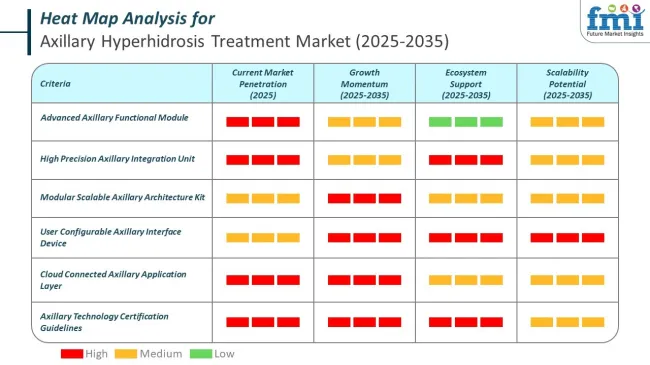
Regulatory bodies ensure that treatments, including medical devices and drug therapies, undergo clinical trials to demonstrate safety and efficacy. These approvals are essential for making treatments available to the public and for securing reimbursement through insurance policies. In regions with less developed regulatory frameworks, the approval process can be slower, delaying access to new treatments. Additionally, less structured reimbursement policies in some areas can limit patient access to advanced therapies, making it harder for individuals to obtain the latest treatments.
Below table representing the anticipated CAGR for the axillary hyperhidrosis treatment market in the world across various semi-annual periods starting from 2025 to 2035. In H1 of the decade 2024 to 2035, the business will be expected to grow at a CAGR of 6.9%, while that of H2 of the same decade will slightly experience 6.4%.
| Particular | Value CAGR |
|---|---|
| H1 (2024 to 2034) | 6.9% |
| H2 (2024 to 2034) | 6.4% |
| H1 (2025 to 2035) | 6.0% |
| H2 (2025 to 2035) | 5.6% |
Moving into the following period, between H1 2025 to H2 2035, the CAGR is expected to go down slightly to 6.0% in the first half and down moderately at 5.6% in the second half. In the first half, the market is expected to be down by 90.00 BPS whereas in the second half, it is expected to be down by 80.00 BPS.
The axillary hyperhidrosis treatment market is segmented based on two primary investment areas: treatment type and distribution channel. By treatment type, the market includes drug therapy, botulinum toxins, and medicated wipes.
In terms of distribution channel, key segments encompass hospitals, general physician’s clinics, retail pharmacy chains, and online sales. Regionally, the market is divided into North America, Latin America, East Asia, South Asia and Pacific, Western Europe, Eastern Europe, and Middle East and Africa.
Drug therapy is projected to remain a core component of the axillary hyperhidrosis treatment market, accounting for approximately 65% of the total value in 2025. This segment includes topical antiperspirants, oral medications, and botulinum toxin injections. Antiperspirants such as aluminum chloride-based products are often preferred as first-line treatments due to their low cost and ease of availability.
Additionally, botulinum toxin therapies offer relatively long-lasting results with minimal invasiveness, appealing to patients who seek alternatives to surgical or energy-based interventions. The consistent performance and adaptability of drug therapies across severity levels make them broadly applicable and accessible, which supports their elevated market share. Despite limitations like temporary relief and potential side effects, continued development of topical agents and FDA approvals are expected to enhance the attractiveness of this segment through 2035.
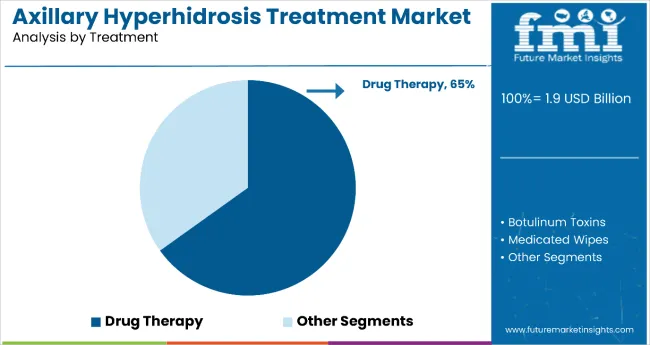
| Treatment Type | Share (2025) |
|---|---|
| Drug Therapy | 65% |
Retail pharmacy chains are expected to account for approximately 35% of the market in 2025. Their widespread geographic coverage, low cost of entry, and accessibility make them a preferred channel for over the counter (OTC) antiperspirants and prescription refills.
Retail chains such as CVS, Walgreens, and Boots stock a wide array of branded and generic treatment options including sprays, wipes, and clinical-strength roll-ons. Additionally, pharmacists often assist in product guidance and help patients understand side effects or usage protocols, especially first-time users.
Their ability to provide both affordability and immediate access has bolstered their position in the market. With increasing consumer preference for convenient, self-managed solutions, this channel is expected to maintain stable growth and enhance its relevance even as online platforms expand.
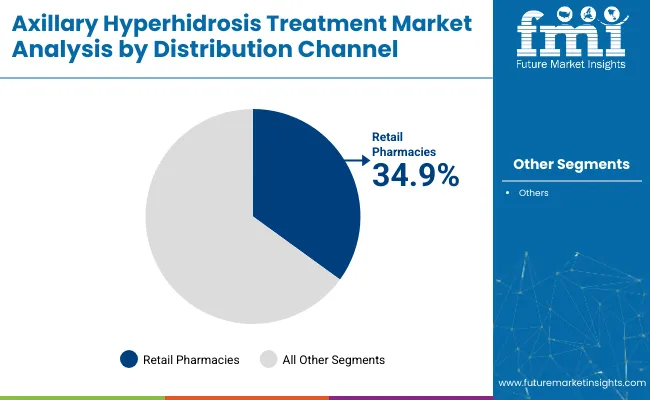
| Distribution Channel | Share |
|---|---|
| Retail Pharmacies | 35% |
Stress and anxiety are among the common reasons found in today's fast pace, which results from demanding jobs, societal pressures, and permanent connectivity in the digital age. Such a psychological fact helps in trigger axillary hyperhidrosis.
Apart from that, the disease burden of obesity is also increasing across worldwide. Obesity is among also one of the major conditions where the sweat production increase because the body needs to cool more intensively in a person who possesses greater body mass.
Thus, widespread dissemination of these lifestyle and environmental factors has seen many people experience symptoms of axillary hyperhidrosis. Most salient reasons for increasing sales of axillary hyperhidrosis treatment have been one of the compelling reasons because of increasing awareness of personal hygiene and aesthetics in modern society.
Visible stains of perspiration on clothing are also related to continuous body odor, where people become embarrassed and lose self-confidence. That makes them pay more attention to managing the symptoms where they are working in social or professional environments.
Long-lasting treatments of Botox injections or non-invasive alternatives like miraDry appeal to those who take pride in ease of access combined with efficiency. This need for confidence in personal and public settings has led to many investing in these advanced solutions, despite the higher costs.
Thus, the lifestyle and environmental changes as well as aesthetic and social concerns is creating demand for effective treatments of axillary hyperhidrosis.
Axillary hyperhidrosis may receive personalized treatment. Personalized treatments are customized to meet the specific needs of the patient.
Unlike standardized solutions, these treatments consider whether the condition is mild, moderate, or severe; a patient's past history; lifestyle; and preferences. For instance, instead of one basic dose for Botox injections, a customizable regimen would set the dose and frequency according to the individual to maximize effectiveness and minimize adverse effects.
These changes toward customized care are significantly shaping the axillary hyperhidrosis treatment market. It has managed to drive innovation among the manufacturers and healthcare providers.
It has led companies to invest in designing diagnostic instruments, as well as in creating treatment protocols that could allow more customization. For example, advanced imaging or sweat-mapping techniques help in identifying areas that necessitate targeted treatment.
The other area of improvement is patient satisfaction and outcome. Personalized treatments are going to make it more likely that patients will benefit from long-term relief, enhancing word-of-mouth referrals and trust in the efficacy of available therapies. This approach is also consistent with the trend in medicine, where precision healthcare has become a major focus for better results in highly individualized care.
Although Botox is very effective in reducing excessive sweating, the effects last only a few months, requiring constant maintenance treatments. This can be inconvenient and impractical for individuals with busy schedules or limited access to medical care.
Most notably, the monetary expense of repeated injections coupled with limited insurance coverage prevents most patients from seeking Botox injections. Pain during the injection procedure may be an additional deterrent for certain patients. Improved insurance coverage and less painful injection techniques would address these barriers to increasing accessibility and rates of adoption.
Prescription drugs like anticholinergics and others, can be used to block nerve signals that enhance sweat production. Although effective, these drugs are often accompanied by side effects such as dry mouth, blurred vision, and constipation, which may deter long-term use. Topical anticholinergics, such as glycopyrronium tosylate in medicated wipes, have been developed to reduce sweating with fewer systemic side effects.
Although antiperspirants and medicated wipes are more available and inexpensive, these are also more short-term-related products. Their effectiveness is short-lived; therefore, these products may not be able to help generate persistent revenue growth within the market. Patients generally desire treatments that yield longer-lasting outcomes, which is a void that the product portfolio is yet to fill.
The market for axillary hyperhidrosis treatments faces several challenges that limit its growth potential. Among these, the temporary nature of Botox injections is a notable barrier.
This has historically kept most patients from treating the disease because they associated advanced procedures such as Botox injections, microwave thermolysis, or surgical interventions with out-of-pocket high expenditure and, hence, lead financial barriers for patients.
As health systems together with private insurers extend coverage for hyperhidrosis treatments, the hurdles facing a patient in seeking professional medical advice and benefiting from clinically validated advanced treatment options instead of dependence solely on OTC products or home remedies reduce significantly.
Besides that, combination therapies are fast becoming the transformative trend in the axillary hyperhidrosis treatment market. In this regard, more holistic and personalized solutions can be provided to patients. Integration of topical treatments, oral medications, and even minimally invasive procedures, such as Botox injections or laser-based technologies can expedite superior treatment outcomes.
Combination therapies cover the varying nature of severity levels of hyperhidrosis and ensure patient care is met with a tailored approach. For example, a patient may benefit short-term from oral anticholinergic medications controlling excessive sweating with Botox injections providing the more chronic relief. A multi-modal strategy improves patient satisfaction and opens up new revenue streams for providers and manufacturers.
Hence development of combination therapies as well as insurance coverage expansion represents significant opportunity in the axillary hyperhidrosis management.
The market is mainly dominated by Tier 1 companies, with an impressive global market share of 54.4%. Leaders within this tier invest in strategic alliances and acquisitions, which further expands their product offerings and cutting-edge technologies. It also heavily invests in clinical trials to ensure its products are safe and effective. Some of the prominent Tier 1 companies are Allergan plc. (AbbVie), Dove, Nivea, Yardley, Oriflame, and many others.
Tier 2 companies constitute 28.8% of the market and are medium-sized players that have a good regional presence. They are interested in collaborations with academic and research institutions to access emerging technologies and accelerate innovation. These companies emphasize adaptability and cost-effective production to bring competitively priced treatments to market. Notable Tier 2 companies include Journey Medical Corporation, Riemann A/S, SweatBlock, Certain Dri, GlaxoSmithKline Plc, and others.
Tier 3 companies operating in niche markets with specialty products introduce diversity to the competitive landscape. Examples include Carpe, SweatStop International, CORAD Healthcare, ZeroSweat and others.
In effect, though it is the Tier 1 companies that propel the competition to market leadership, Tier 2 and Tier 3 companies help ensure innovation, price competitiveness, and market dynamism.
The section below covers the industry analysis for the axillary hyperhidrosis treatment landscape for different countries. Market demand analysis on key countries in several regions of the globe, including North America, Latin America, East Asia, South Asia & Pacific, Western Europe, Eastern Europe and Middle Ease & Africa, is provided.
The United States is anticipated to remain at the forefront in North America, with higher market share through 2035. In South Asia & Pacific, India is projected to witness a CAGR of 10.1% by 2035.
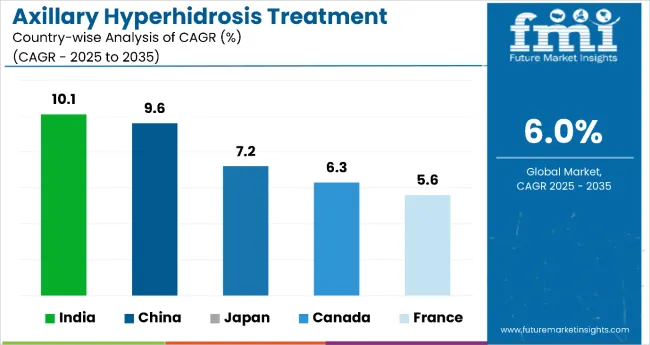
| Countries | Value CAGR (2025 to 2035) |
|---|---|
| United States | 3.2% |
| Canada | 6.3% |
| China | 9.6% |
| Japan | 7.2% |
| India | 10.1% |
| Germany | 3.8% |
| United Kingdom | 4.3% |
| France | 5.6% |
The axillary hyperhidrosis treatment market for United States is expected to grow at a CAGR of 3.2% from 2025 to 2035. The United States remains as the market leader in North America for the axillary hyperhidrosis treatments. Rising awareness of this hyperhidrosis condition leading to high patient footfall in clinical settings for diagnosis and treatment leading to future growth.
The sensitivity to personal comfort and aesthetics drives the Americans consumers in the market place of seeking more aggressive treatment for hyperhidrosis. In this context, advanced treatment modalities like FDA-approved microwave thermolysis devices and Botox injections are being driven in this market.
Also, in the United States, the health care providers take prompt decisions with respect to acceptance of new technologies like laser-based and minimally invasive procedures, to deliver the best outcomes and to gain maximum satisfaction for the patients.
More patients are seeking treatment because treatments for hyperhidrosis are increasingly covered by insurance plans in the United States, hence reducing the burden of the expenses on the patient. This country is home to major pharmaceutical companies, with strong R&D initiatives that further expand the scope of innovative solutions. It is, therefore, a dynamic and fast-growing market
Germany remains the biggest absorber tissue space market in Europe. The market is expected to grow at an impressive CAGR of 3.8% from 2025 to 2035. The German industry for axillary hyperhidrosis treatments benefits from a well-structured system regarding the healthcare system, with most of the treatments falling under public or private health insurance.
This improves the access of various socio-economic group patients to efficacious solutions without financial burdens. The country also has a high density of specialized dermatology clinics, which offers advanced treatments like Botox and glycopyrronium tosylate. There had been an attempt by the German clinics to offer comprehensive counseling.
Hyperhidrosis does not hold any stigmata any more. Even, diagnostic cases increased, due to increased interest from medical technology. Increased innovation regarding Germany also used more and new equipment.
An enhanced interest to focus on lifestyles as well as productive life in work will boost the individuals that also increased gradually and mainly with heightened societal awareness.
Indian axillary hyperhidrosis treatment market is expected to lead the South Asia-Pacific region with a CAGR of 10.1% through 2035 in the axillary hyperhidrosis treatment market. Axillary hyperhidrosis is a growing market in India due to rising awareness about the condition in the urban population.
Hyperhidrosis has, over the years been underdiagnosed but has recently come under focus with the targeted campaign from medical professionals and pharmaceutical companies. The Indian middle class has increased with an upsurge in disposable incomes and hence has fueled demand for aesthetic and therapeutic treatments.
Due to cheap advanced solutions, making the solution more accessible to more patients due to the availability of generic treatments and localized remedies, the widened availability has helped bring more patients into the spectrum of the solution.
Increased stress levels and longer working hours in India have increased hyperhidrosis. This, in turn, has been supplemented by the proliferation of private dermatology clinics in metros, which ensures that patients today have more options than before for treatment, thereby pushing growth in the market.
The market players are using strategies to stay competitive, such as product differentiation through innovative formulations, strategic partnerships with healthcare providers for distribution. Another key strategic focus of these companies is to actively look for strategic partners to bolster their product portfolios and expand their global market presence.
| Report Attributes | Details |
|---|---|
| Current Total Market Size (2025) | USD 1.9 billion |
| Projected Market Size (2035) | USD 3.4 billion |
| CAGR (2025 to 2035) | 6.00% |
| Base Year for Estimation | 2024 |
| Historical Period | 2020 to 2024 |
| Projections Period | 2025 to 2035 |
| Quantitative Units | USD million for value and thousand prescriptions for volume |
| Treatments Analyzed (Segment 1) | Drug Therapy, Botulinum Toxins, Medicated Wipes |
| Distribution Channels Analyzed (Segment 2) | Hospitals, General Physician’s Clinics, Retail Pharmacy Chains, Online Sales |
| Regions Covered | North America; Latin America; Western Europe; Eastern Europe; South Asia and Pacific; East Asia; Middle East & Africa |
| Countries Covered | United States, Canada, Brazil, Germany, United Kingdom, France, Italy, Spain, Netherlands, China, India, Japan, South Korea, GCC Countries, South Africa |
| Key Players influencing the Axillary Hyperhidrosis Treatment Market | Allergan plc. (AbbVie), Journey Medical Corporation (Dermira, Inc.), Riemann A/S (Orkla), SweatBlock, Certain Dri, STRATUS PHARMACEUTICALS INC, Duradry, Persōn & Covey, GlaxoSmithKline Plc., Carpe, SweatStop® International, CORAD Healthcare, ZeroSweat |
| Additional Attributes | Innovation in topical antiperspirants and aluminum chloride formulas, Increased adoption of botulinum injections in clinical settings, Rise of online OTC solutions and telemedicine channels, Patient demand for non-invasive treatments and lifestyle-oriented product formats, Regional market dynamics based on dermatology care access |
| Customization and Pricing | Customization and Pricing Available on Request |
In terms of treatment, the industry is divided into- drug therapy, botulinum toxins, and medicated wipes.
In terms of end user, the industry is segregated into- hospitals, general physician’s clinics, retail pharmacy chains and online sales
Key countries of North America, Latin America, Western Europe, Eastern Europe, South Asia and Pacific, East Asia and Middle East and Africa (MEA) have been covered in the report.
The axillary hyperhidrosis treatment market is projected to expand at a CAGR of 6% between 2025 and 2035, driven by increasing patient awareness and the development of non-invasive therapies.
By 2035, the axillary hyperhidrosis treatment market is expected to reach USD 3.42 billion, up from USD 1.91 billion in 2025.
Drug therapy is anticipated to hold the highest share in the axillary hyperhidrosis treatment market, accounting for 65.1% of the market in 2025 due to its cost-effectiveness and ease of access.
Key drivers of the axillary hyperhidrosis treatment market include rising concerns around personal aesthetics, increased availability of minimally invasive options, and advancements in topical and injectable therapies.
The Asia Pacific region is expected to lead in growth, with India forecasted to record a CAGR of 10.1% from 2025 to 2035 due to rising awareness, expanding healthcare access, and increasing urban demand.






Our Research Products

The "Full Research Suite" delivers actionable market intel, deep dives on markets or technologies, so clients act faster, cut risk, and unlock growth.

The Leaderboard benchmarks and ranks top vendors, classifying them as Established Leaders, Leading Challengers, or Disruptors & Challengers.

Locates where complements amplify value and substitutes erode it, forecasting net impact by horizon

We deliver granular, decision-grade intel: market sizing, 5-year forecasts, pricing, adoption, usage, revenue, and operational KPIs—plus competitor tracking, regulation, and value chains—across 60 countries broadly.

Spot the shifts before they hit your P&L. We track inflection points, adoption curves, pricing moves, and ecosystem plays to show where demand is heading, why it is changing, and what to do next across high-growth markets and disruptive tech

Real-time reads of user behavior. We track shifting priorities, perceptions of today’s and next-gen services, and provider experience, then pace how fast tech moves from trial to adoption, blending buyer, consumer, and channel inputs with social signals (#WhySwitch, #UX).

Partner with our analyst team to build a custom report designed around your business priorities. From analysing market trends to assessing competitors or crafting bespoke datasets, we tailor insights to your needs.
Supplier Intelligence
Discovery & Profiling
Capacity & Footprint
Performance & Risk
Compliance & Governance
Commercial Readiness
Who Supplies Whom
Scorecards & Shortlists
Playbooks & Docs
Category Intelligence
Definition & Scope
Demand & Use Cases
Cost Drivers
Market Structure
Supply Chain Map
Trade & Policy
Operating Norms
Deliverables
Buyer Intelligence
Account Basics
Spend & Scope
Procurement Model
Vendor Requirements
Terms & Policies
Entry Strategy
Pain Points & Triggers
Outputs
Pricing Analysis
Benchmarks
Trends
Should-Cost
Indexation
Landed Cost
Commercial Terms
Deliverables
Brand Analysis
Positioning & Value Prop
Share & Presence
Customer Evidence
Go-to-Market
Digital & Reputation
Compliance & Trust
KPIs & Gaps
Outputs
Full Research Suite comprises of:
Market outlook & trends analysis
Interviews & case studies
Strategic recommendations
Vendor profiles & capabilities analysis
5-year forecasts
8 regions and 60+ country-level data splits
Market segment data splits
12 months of continuous data updates
DELIVERED AS:
PDF EXCEL ONLINE
China Axillary Hyperhidrosis Treatment Market Analysis – Size, Share & Trends 2025-2035
India Axillary Hyperhidrosis Treatment Market Outlook – Demand, Growth & Forecast 2025-2035
Japan Axillary Hyperhidrosis Treatment Market Insights – Size, Share & Trends 2025-2035
Canada Axillary Hyperhidrosis Treatment Market Analysis – Demand, Growth & Forecast 2025-2035
United States Axillary Hyperhidrosis Treatment Market Growth – Size, Share & Industry Trends 2025-2035
Treatment-Resistant Hypertension Management Market Size and Share Forecast Outlook 2025 to 2035
Treatment-Resistant Depression Treatment Market Size and Share Forecast Outlook 2025 to 2035
Treatment Pumps Market Insights Growth & Demand Forecast 2025 to 2035
Pretreatment Coatings Market Size and Share Forecast Outlook 2025 to 2035
Air Treatment Ozone Generator Market Size and Share Forecast Outlook 2025 to 2035
CNS Treatment and Therapy Market Insights - Trends & Growth Forecast 2025 to 2035
Seed Treatment Materials Market Size and Share Forecast Outlook 2025 to 2035
Acne Treatment Solutions Market Size and Share Forecast Outlook 2025 to 2035
Scar Treatment Market Overview - Growth & Demand Forecast 2025 to 2035
Soil Treatment Chemicals Market
Water Treatment System Market Size and Share Forecast Outlook 2025 to 2035
Water Treatment Chemical Market Size and Share Forecast Outlook 2025 to 2035
Algae Treatment Chemical Market Forecast and Outlook 2025 to 2035
Water Treatment Market Size and Share Forecast Outlook 2025 to 2035
Water Treatment Ozone Generator Market Size and Share Forecast Outlook 2025 to 2035

Thank you!
You will receive an email from our Business Development Manager. Please be sure to check your SPAM/JUNK folder too.
Chat With
MaRIA